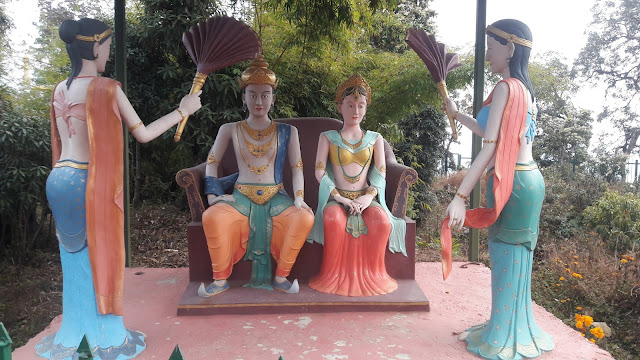The 12 deeds of Shakyamuni Buddha
Over 2,500 years ago, the devas prophesied, “In twelve years a great bodhisattva will be born who will become either a universal ruler or a buddha, and will be known as Shakyamuni.” The Bodhisattva Mahasattva who resided in Tushita Pure Land heard this and moved by compassion, resolved to take rebirth in India, on the Jambudvipa continent, as the son of King Shuddhodana and Queen Mayadevi of the Shakya clan.
Buddha Shakyamuni manifested the 12 deeds, as do all buddhas, as implicit teachings for the beings of our world system, in addition to the explicit teachings he gave during his life. Ven. George Churinoff said, “Through the various deeds he showed that that we too, born from a mother’s womb as the Buddha seemed to be, can attain enlightenment. The Buddha’s deeds of leaving his family and palace and his passing away into parinirvana are obvious teachings to his disciples about renunciation and impermanence, for example.”
There are different authentic versions of these 12 deeds which are presented separately according to one list are combined into one according to another. The deeds depicted in the Art of painting follow the order presented in His Holiness the Lam Odzer Pelzang Opening the Eye of New Awareness in Buddha Pelri Park, Mukazor In Bhutan.
1. Descent:
The Buddha, in his previous life, was at the helm of gods in Tusita heaven. When it was time to come down to earth, he passed on the celestial regal duties to his successor, Maitreya, and descended to earth. This is the first act of the Buddha although it should not be confused with the descent from Trāyastrimśa heaven later in his life.
2. Conception:
After checking the appropriate place, race, time, father and mother, the Buddha entered the womb of Queen Māyādevī in the form of a white elephant with six tusks.
3. Birth:
In the third act, the Buddha was born miraculously in Lumbini, allegedly from the right armpit of his mother. He is believed to have taken seven steps right after his birth and declared: “I am the supreme in the world.”
4. Upbringing:
The Buddha, as Prince Siddhārtha, grew up in the palace of Kapilavastu mastering all the arts and skills expected of a prince in his days.
5. Princely Life:
Prince Siddhartha ruled over the kingdom with his father and lived a luxurious life in the palace. He married Yaśodhara and had a son named Rāhula.
6. Renunciation:
Disillusioned with the state of ordinary life after he came in direct contact with illness, old age, death and renunciation, Prince Siddhārtha renounced his palace life in search of solution to the problems of life.
7. Austerity:
As was common in his time, he followed physical penance as a way to liberation. Siddhārtha spent six years undergoing a severe fast and meditation.
8. Adopting Middle Way:
When austere penance, like decadent palace life, did not lead him to inner fulfilment and liberation, he eschewed the two extremes of excessive indulgence and physical austerity and adopted the Middle Way to enlightenment.
9. Overcoming Evil:
After eating the cream he received from Sujātā and sitting on the comfortable mat, Siddhārtha entered a meditative absorption and overcame the evil forces of attachment, aggression and ignorance.
10. Enlightenment:
Having defeated the inner demons, the Buddha attained full enlightenment under the Bodhi tree when he turned 35.
11. Teaching:
Seven weeks after he attained enlightenment, the Buddha gave his first sermon at Deer Park to his five former colleagues. This began 45 years of his teaching and spiritual career.
12. Passing Away:
The Buddha finally entered the state of Mahāparinirvāna on his 81st birthday. As he did with his life, the Buddha used his final act of dying also to deliver the message of impermanence.














